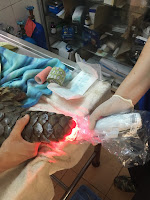Day 7
Day 7 we anaesthetised an adult pangolin for further assessment of a tail abscess, he was particularly difficult to manage conscious, getting extremely stressed when handled and made it impossible to examine or treat, as he curled his tail over his head leaving us no access to the abscess on the mid ventral tail! Stress is a big welfare factor to consider, and from their experience the vets believe it is also a large contributor to death of captive pangolins.
Once anaesthetised he could be examined thoroughly, the abscess was small, bursting out between two scales but a fairly deep pocket, and with a lot of purulent exudate. It was decided that to enable the best chance of healing, the two adjacent scales would have to be removed. It is often these small problems that can lead to further issues and tail necrosis resulting in partial tail amputations, if they are not treated early on.
Preparation for surgery consisted of scrubbing the surrounding scales with a tooth brush and hibi scrub, it was flushed with saline and alcohol. Antibiotics, pain relief, fluids and vitamin solution was administered and a full clinical examination. With Huongs guidance I performed the minor surgery, removing the two scales from their attachment to the skin. This then allowed the abscess to be opened up and completely flushed and debrided. The underlying tissue was healthy and we hoped it would heal quickly without issues. Due to the location and amount of exudate a dressing was required to prevent further contamination and infection. There was also minor dermatitis surrounding the area, which I cleaned and flushed with dilute iodine solution.
In the afternoon we anaesthetised two further pangolins for an eye examination, both of which had inflamed and ulcerated eyes, another common problem seen. Eye injuries can be caused by the abrasive nets they are tightly kept in after seizure; they can also injure their own eyes trying to curl up if they are handled inappropriately. During the anaesthesia a blood sample was obtained to spin and produce some serum eye drops. The serum drops are applied twice daily alongside an eye flush and antibiotic eye drops and pain relief.
One of the animals who was anesthetised also had a healing wound on its back. Previously a scale had been removed to open up a deep infected wound, spinal bone was actually visible. It had now granulated but had a lot of exudate and not yet epithelialised. With a dressing in place to absorb the exudate and provide some protection it was hoped it would start epithelialisation. To ensure the dressing stayed in place suture material was threaded through premade holes in the dorsal scales to secure, another novel dressing technique.
Dinner was with the other volunteers in the restaurant, sharing our stories and pictures from the day and the work that happened across all three animal rescue centres. It was a beautiful clear night heading back to the tourist centre after dinner, the stars were incredible.
Once anaesthetised he could be examined thoroughly, the abscess was small, bursting out between two scales but a fairly deep pocket, and with a lot of purulent exudate. It was decided that to enable the best chance of healing, the two adjacent scales would have to be removed. It is often these small problems that can lead to further issues and tail necrosis resulting in partial tail amputations, if they are not treated early on.
Preparation for surgery consisted of scrubbing the surrounding scales with a tooth brush and hibi scrub, it was flushed with saline and alcohol. Antibiotics, pain relief, fluids and vitamin solution was administered and a full clinical examination. With Huongs guidance I performed the minor surgery, removing the two scales from their attachment to the skin. This then allowed the abscess to be opened up and completely flushed and debrided. The underlying tissue was healthy and we hoped it would heal quickly without issues. Due to the location and amount of exudate a dressing was required to prevent further contamination and infection. There was also minor dermatitis surrounding the area, which I cleaned and flushed with dilute iodine solution.
In the afternoon we anaesthetised two further pangolins for an eye examination, both of which had inflamed and ulcerated eyes, another common problem seen. Eye injuries can be caused by the abrasive nets they are tightly kept in after seizure; they can also injure their own eyes trying to curl up if they are handled inappropriately. During the anaesthesia a blood sample was obtained to spin and produce some serum eye drops. The serum drops are applied twice daily alongside an eye flush and antibiotic eye drops and pain relief.
One of the animals who was anesthetised also had a healing wound on its back. Previously a scale had been removed to open up a deep infected wound, spinal bone was actually visible. It had now granulated but had a lot of exudate and not yet epithelialised. With a dressing in place to absorb the exudate and provide some protection it was hoped it would start epithelialisation. To ensure the dressing stayed in place suture material was threaded through premade holes in the dorsal scales to secure, another novel dressing technique.
Dinner was with the other volunteers in the restaurant, sharing our stories and pictures from the day and the work that happened across all three animal rescue centres. It was a beautiful clear night heading back to the tourist centre after dinner, the stars were incredible.








Comments
Post a Comment